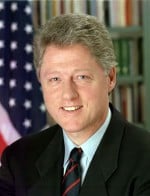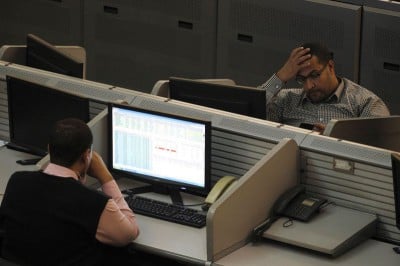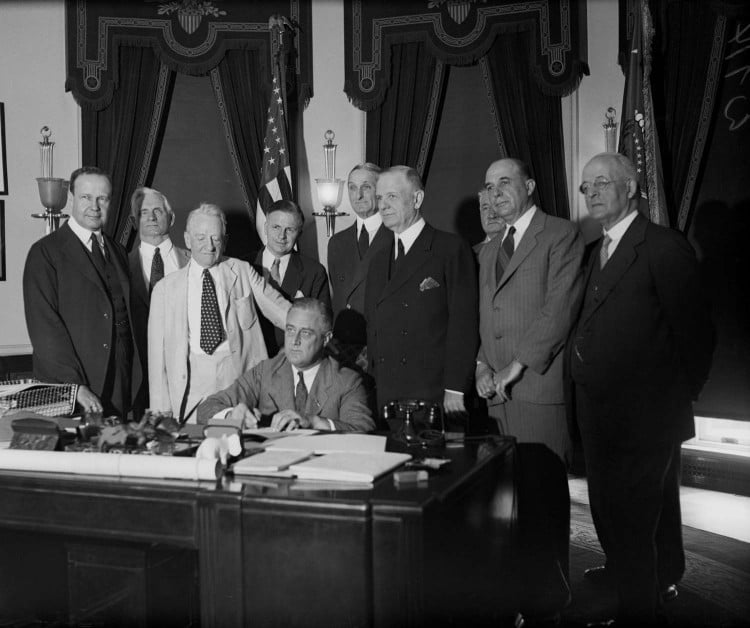
NARA
To understand which president created the most jobs, you must look at the percentage as well as the total number of jobs generated. Over time, the economy has grown, which has made it easier for modern presidents to create a greater number of jobs. For example, around 156 million people were working in December 2021. That's more than triple the 47.6 million employed in 1929, the earliest year measured by the Bureau of Labor Statistics.
Presidents Who Created the Most Jobs
President Bill Clinton created the greatest total number of jobs during his two terms. He added 18.6 million, a 15.6% increase.
President Franklin D. Roosevelt created the most, percentage-wise, with a 33.8% increase. During his term, he had to recover from the depths of the Great Depression. But, it's not fair to use that because he was in office for more than two terms. Out of all the two-term presidents, Franklin D. Roosevelt added the highest percentage of jobs, with a 38.5% increase.
Here are the 10 presidents who created the most jobs between 1929 and 2022, with each entry noting the percentage jobs increased during the president's term(s):
Bill Clinton (1993-2001): 18.6 million
Karl Gehring / Getty Images
President Clinton added 18.6 million jobs. He was the top job creator in terms of total numbers, but the third-largest percentage increase with a 15.6% increase. There were 119 million employed at the beginning of his term and 137.6 million people employed by the end of his term in December 2000.
Unlike most presidents, he did this through contractionary fiscal policy. He presided over eight years of steady economic growth. He created a $128 billion budget surplus in his final year as president, making him the more recent president to do so. His Omnibus Budget Reconciliation Act of 1993 raised the top tax rate from 28% to 39.6% for high-income earners. He increased the top corporate tax rate from 34% to 35%.
At the same time, President Clinton cut welfare spending. Recipients had to get jobs after two years. His policies helped reduce the number of people on welfare. Between August 1996 and March 2003, the number of welfare recipients fell by 59%, from 12.2 million to 4.96 million people.
Ronald Reagan (1981-1989): 16.5 million
Ronald Reagan Presidential Library
President Reagan added 16.5 million jobs during his eight-year term, a 16.6% increase. Reagan added the second-largest number of total jobs, which was also the second-highest percent increase. There were 116.1 million people working in December 1988 compared to 99.6 million in December 1980.
Reagan responded to the 1981 recession with Reaganomics—an expansive fiscal policy based on supply-side economics. Reagan cut the top income tax rate from 70% to 28%. He also cut the top corporate tax rate from 46% to 34%. His policies more than doubled the debt from 1980 to 1989.
Franklin D. Roosevelt (1933-1945): 15 million
Library of Congress
President Roosevelt increased jobs by 38.5%, the largest percentage increase of all presidents. He added 15 million workers to the 38.9 million who were working at the start of his term. That made him the fourth largest job creator in sheer numbers. This job growth was after he created the New Deal to end the Great Depression. FDR also built up the economy to enter World War II.
Jimmy Carter (1977-1981): 9.8 million
Bettmann/Getty Images
President Jimmy Carter added 9.8 million jobs, a 10.9% increase. He did that by adding $299 billion to the $698.8 billion national debt, an almost 43% increase.
Richard Nixon (1969-1974): 9.4 million
Dirck Halstead / Liaison / Getty Images
President Nixon added 9.4 million jobs to the 76.7 million workers at the end of the Johnson administration. That's a 12.2% increase.
He initially presided over a growing economy. Americans celebrated by importing more goods. As they paid in dollars, foreigners started redeeming them for gold. In 1973, Nixon ended the gold standard entirely. Gold prices rose to nearly $60 an ounce by mid-1972 and $90 an ounce by early 1973. No longer tethered to the price of gold, the value of the dollar plummeted, triggering inflation.
Nixon won re-election in 1972. But his actions led to the 1973-1975 recession coupled with double-digit inflation.
Barack Obama (2009-2017): 8.9 million
Mark Wilson / Getty Images
President Obama created 8.9 million jobs by the end of December 2016, a 6.1% increase over the work force he took over after the end of the Bush administration.
But that doesn't give the total picture. The economy lost 8.7 million jobs as a result of the Great Recession, which took place from late-2007 through mid-2009. From June 2009 to December 2016, Obama created 12.2 million jobs, an 8.7% increase.
Obama attacked the Great Recession with the American Recovery and Reinvestment Act. It created jobs through public works. Many of those jobs were in construction. That successfully reduced the unemployment rate. But that meant Obama increased the debt by $8.6 trillion, a 72.3% increase.
Job creation would have been stronger during Obama's term if Congress hadn't passed sequestration. In his last FOMC meeting, Federal Reserve Chairman Ben Bernanke noted that these austerity measures forced the government to shed 700,000 jobs in four years. In the prior recovery from the 2001 recession, the economy added 600,000 jobs during the same period.
Lyndon B. Johnson (1963-1969): 8.6 million
Yoichi Okamoto / LBJ Library
President Johnson added 8.6 million jobs to 68.2 million employed in December 1963; that's a 12.6% increase.
LBJ spent on social programs, such as Medicare, Medicaid, and the War on Poverty. That increased the debt by 15.6%. By the time he left office, the economy was growing a robust 4.9% but inflation rose to 4.4%.
Harry Truman (1945-1953): 7 million
Fox Photos / Getty Images
President Truman added almost 7 million jobs. The 13% increase was the fourth-largest among modern presidents.
Despite fighting World War II and starting the Korean War, Truman only increased the national debt by 1.5%.
George W. Bush (2001-2009): 5.7 million
Eric Draper / The White House / Getty Images
President Bush created 5.7 million jobs, a 4.2% increase. He struggled with two recessions. He lost 3 million jobs in 2008, his last year in office.
The job gains occurred before that, as he recovered from the 2001 recession. He responded to it with stimulus checks and the Bush tax cuts. He was helped by low-interest rates from the Fed's expansive monetary policy.
Dwight Eisenhower (1953-1961): 4.8 million
Keystone / Getty Images
President Eisenhower added 4.8 million jobs, a 7.9% increase. He increased the debt by 8.6%, or $22.9 billion as he fought two recessions. The end of the Korean War caused the 1953 recession, and higher interest rates caused the 1957 recession.
Part of Eisenhower's success with job creation was due to his creation of the Interstate Highway System. He spent $25 billion to build 41,000 miles of road.
How Do Presidents Create Jobs?
A president's record at job creation depends somewhat on the business cycle. For example, those who inherited a recession, like Clinton, Obama, Reagan, Carter, and LBJ, did better at job creation. They started with a low base and so had nowhere to go but up. Those who were in office when recessions started did worse but Nixon and Bush were outliers.
Presidents have many tools to create jobs. The most important tools are expansive fiscal policy, especially deficit spending. Government spending can employ people directly and through contracting. That will encourage the private sector to hire through greater demand from consumers. But all presidents must have Congressional budget approval before they can increase spending or cut taxes.
A president does have one unique tool. He can inspire confidence through a compelling vision. A president who can articulate a message that reverses doubt and pessimism may be more successful in creating jobs.
How We Determined Which Presidents Created the Most Jobs
These numbers are taken from the household survey data collected by the Bureau of Labor Statistics (BLS). Between 1929 and 1947, they are taken from a special BLS survey. Both surveys count the total number of people employed. That includes paid employees, self-employed people, private household workers, farm-workers, and temporarily unpaid leave workers.
The number of jobs added during each president's term was calculated by subtracting the total number of jobs when he entered office from the number of jobs when he left office. The number is taken from the household survey data for December of the prior year.
The Bureau of Labor Statistics publishes two employment statistics for each month, taken from two different sources. The household survey measures number of people employed. The non-farm payroll report measures the number of jobs created by businesses. This number does not include the self-employed, private household employees, farm-workers, or temporarily unpaid leave workers. An individual with two jobs is counted twice by the payroll survey.
Frequently Asked Questions (FAQs)
What information technology job has the highest growth rate?
Software developers, quality assurance analysts, and testers are among the fastest-growing fields across all industries. The Bureau of Labor Statistics projects that jobs in this field will grow by roughly 22% between 2020 and 2030.
What executive department promotes job creation?
The Department of Commerce was created to promote job creation, economic growth, and opportunity.






